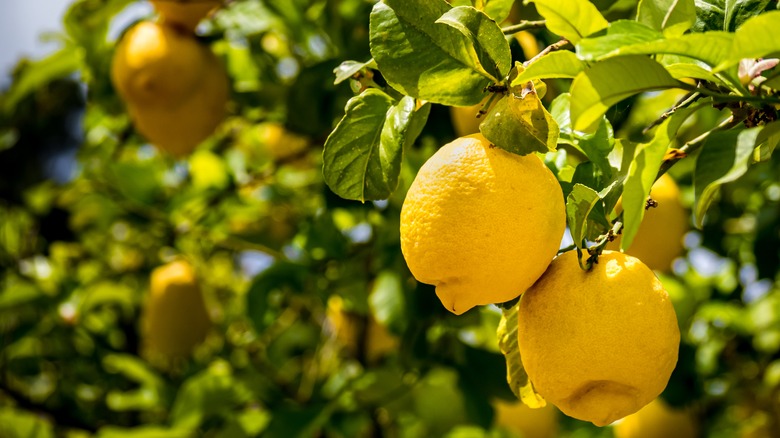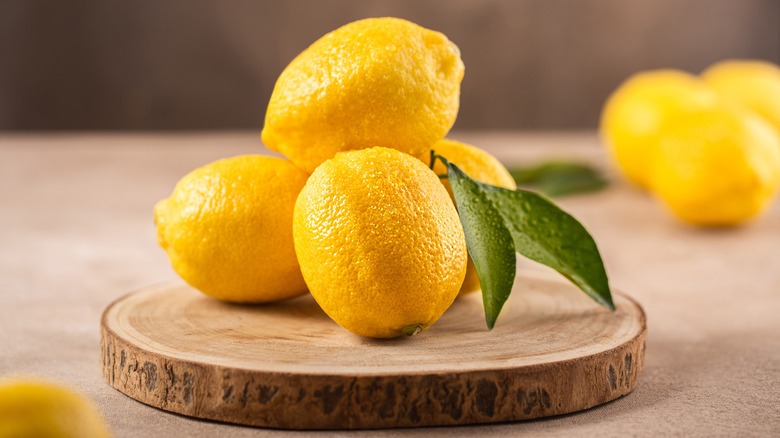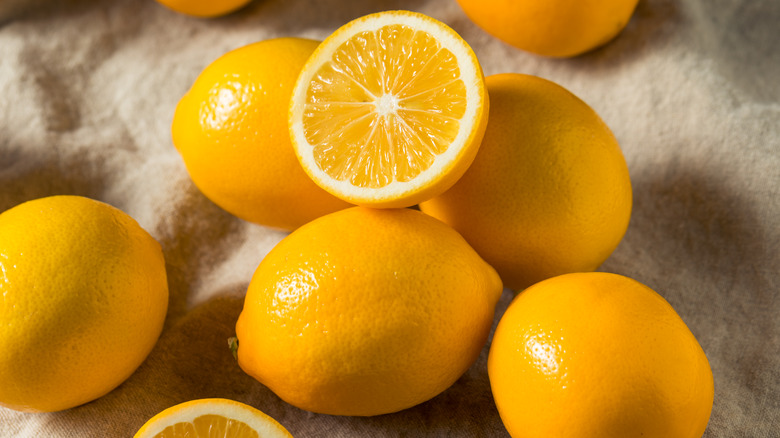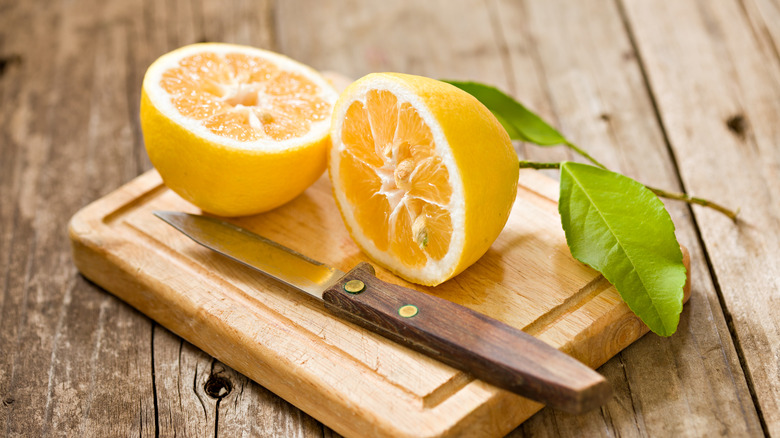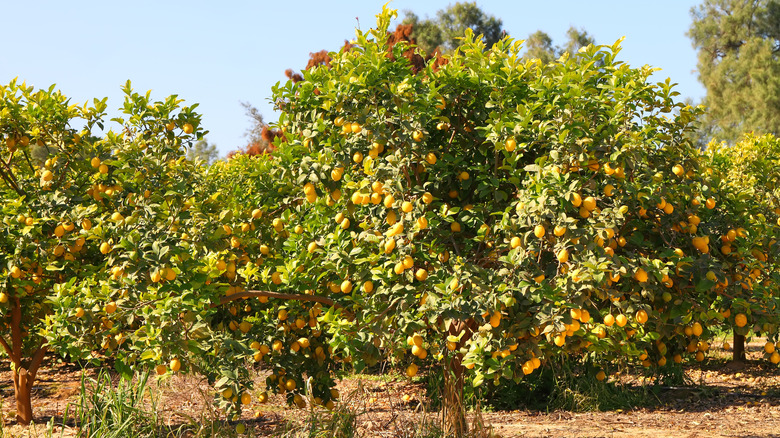What's The Difference Between Standard And Meyer Lemons?
If there is one food product where it seems like there should be no difference in what you buy, it's lemons. We accept the dozens of different apple varieties or nitpick between our favorite lettuce greens, yet when it comes to our workhorse citrus fruit, a lemon is just supposed to be a lemon. Their astringent acidity blinds a lot of people to any differences in taste, and for most of recent history in the U.S., you would only see one option at the supermarket, which would just be called "lemon." Of course, the world of food is a wildly diverse place, and it turns out there are actually more than 30 types of lemon out there. As a wider range of produce ends up in our local stores, the Meyer lemon is one kind that has started showing up with far more frequency.
It can be easy to dismiss new options like Meyer lemons as pure marketing; a way to squeeze a little extra money out of people. But, Meyer lemons aren't really new — they've been around for over a hundred years — it's just that they've only started breaking through as a product in the U.S. recently as consumers have come to realize they really are different from standard lemons. Cook with them, and you will see that Meyer lemons have a distinct taste and complexity that sometimes cuts against what you expect from a lemon and lends itself to different recipes and uses.
What are standard lemons?
When you see a standard lemon at the store, it is usually one of two cultivars: the Lisbon lemon or the Eureka. While technically separate breeds, Lisbon and Eureka lemons are functionally identical in taste and almost the same in appearance, with Eurekas being slightly more rough textured and with a smaller bump on the ends. Eurekas also have slightly thicker skin, which makes a difference when zesting them. They both share the characteristic bright yellow coloring of a normal supermarket lemon.
Lemons are not found in the wild. Despite being cultivated for thousands of years, they are actually an example of man-made produce as they are a hybrid cross between a citron species and bitter orange. The first lemons have been traced all the way back to the Himalayan region in either modern-day Southwest China or the Northern Indian subcontinent. Lisbon lemons were first grown in Portugal before making their way to the U.S. in the 19th century, while the Eureka variety originated in California as an offshoot of Italian lemon trees planted around Los Angeles. Although lemons in the U.S. are grown in both Arizona and Florida, most lemons produced in the country come from California thanks to its milder Mediterranean climate.
What are Meyer lemons?
Meyer lemons were first brought over to the United States in 1908, although they have a longer history than that. They got their name from agricultural explorer Frank N. Meyer, an employee of the U.S. Department of Agriculture who was sent to Asia to gather samples of plant species that weren't found domestically. Meyer introduced almost 2,500 samples to the country. Despite taking his name in the U.S., Meyer lemons originated in China, where they were thought to have been created by crossing another variety of lemon with a Mandarin orange. In its home country, it was primarily an ornamental plant prized for its vibrant color.
The new lemon took a while to gain a commercial foothold in the United States and stayed primarily a garden plant, as its thin skin made it hard to distribute. In fact, they almost died off completely in California due to a citrus disease but were rescued with the breeding of one disease-resistant stock that became the basis for the current Meyer Lemon.
The popularizing of the Meyer Lemon didn't happen until the 2000s and is generally credited to two women. Chez Panisse chef Alice Waters started using them at her popular and influential restaurant and championed the breed in her Chez Panisse Cafe Cookbook. The other big name was Martha Stewart, who began featuring them in dessert recipes like lemon pine nut tart and lemon coffee cake.
Standard lemons are larger and more textured
There are several clear visual distinctions that can help you tell Meyer lemons apart from standard lemons, even without a label. Standard lemons are a brighter, lighter shade of pure yellow. They have the classic oblong shape with bumps on the end that we associate with lemons and, although the texture can vary by breed, they tend to have some degree of a bumpy, textured exterior. Standard lemons also have thick rinds that can produce plenty of lemon zest, and have a significant amount of pith, which you can tell just by squeezing them and feeling how little they give at first.
The first difference you'll notice with Meyer lemons is that they are smaller than your standard lemon. The color of Meyers is deeper and darker with an almost yolky orange hue that hints at its heritage as an orange crossbreed, and it even has a darker yellow pulp. They are also much more round than a classic lemon. Finally, the Meyer lemon has a very smooth texture to its skin. The peel is considerably thinner with almost no pith. In fact, the skin and pith of Meyer lemons are so thin that you can bite right into it and eat a bite of lemon rind with no issue. They are also quite juicy compared to standard lemons, which gives them a more squishy feel when squeezed.
Meyer lemons are sweeter and more complex
While the appearance shows the clear difference between Meyer lemons and standard varieties, the most important difference is taste, and that's where Meyer lemons can really shock people. Because they are crossed with Mandarin oranges, Meyer lemons are considerably less acidic and noticeably sweeter compared to what most people expect from lemons. They are so much less tart that they can be enjoyed raw, and tests have found that standard lemon juice is 1.3 times more acidic than Meyer lemon juice. The lack of pith contributes to that, as it cuts down on the bitter taste associated with lemons. Meyer lemons also have more complexity than normal lemons, with a distinct floral aroma and taste. Even the rind has a more vibrant and distinct flavor when zested.
Standard lemons taste, well, like lemons. It's not just that they lack the sweetness of Meyer lemons but they have a distinct mix of acidity, sourness, and bitterness that makes them famously tough to eat. But, that same flavor mix is also why cooking with lemons is so useful, as they can balance out a lot of dishes that are too heavy, sweet, or savory. Standard lemons are distinctly bright and punchy in flavor — more so than Meyers — and you might miss that tang when substituting one for the other. The boldness of standard lemons can be just as welcome as the sweet complexity of Meyer lemons depending on your tastes.
Standard lemons are available year-round
We take for granted that lots of basic products like lemons will always be available to us in grocery stores, but standard lemons are impressive as a true "four-season" fruit. Lemon trees grow continuously throughout the year, and even though the optimal time for harvesting them is in the winter, the heartiness of standard lemons means that they can be harvested and shipped throughout the country year-round. The downside is that they need to be grown in very specific mild climates that don't frost very often. Thankfully, we have places like Florida and California that make lemons available to everyone in the country all the time.
Meyer lemons, however, are a much more seasonal product. Even as Meyer lemons have moved from backyards and farmers markets into grocery stores, they are a citrus that is usually only available in winter and early spring. The peak time is January and February. The shorter growing season and the same problems with thin skin that made growers slow to adapt them make Meyer lemons more expensive and still limited in availability. Outside of citrus-growing regions, you may have more luck finding them at specialty and organic groceries, or you might have to resort to ordering them online.
Meyer lemons are often better for desserts
On a basic level, Meyer lemons and standard lemons can be substituted for each other as they both have a similar acidic citrus flavor, but there will be a noticeable difference in some dishes. Recipes that specifically call for Meyer lemons will not taste the same with normal lemons' stronger, harsher flavor, and Meyers won't make recipes that use normal lemons pop the same way. If a recipe calls for Meyer lemons, and you don't have them, one substitute that can come close is mixing normal lemon juice with fresh tangerine juice.
Although both lemon types have a litany of uses, Meyer lemons' sweet, complex flavor makes them a great choice for desserts like lemon cookies or lemon meringue pie. They still have enough tang to work and will bring more depth without needing as much added sugar as normal lemon desserts. Meyer lemon juice is also a great choice to mix up a cocktail, and they can add a nice balance of mild sweetness and bite when squeezed over fish.
For more savory applications where lemon is used primarily as a way to boost acid, you may want standard lemons to remain your go-to. Salad dressings, sauces, pasta al limone, and meat dishes all benefit from the strong kick of a standard lemon. Meyer lemons won't completely replace standard lemons in your kitchen, but if you have access to both, you open up a wider world of lemony flavor.
